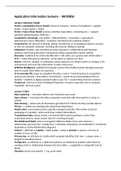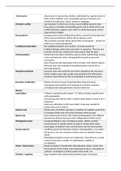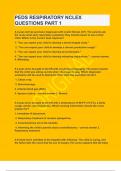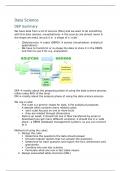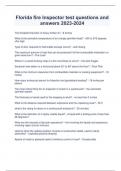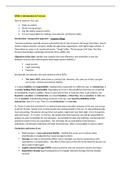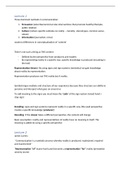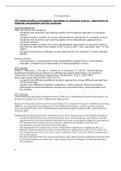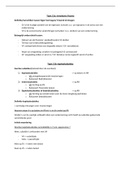Application Information Systems – INF20806
Lecture 2 Business Model
Porter’s Competitive Forces Model: threat of entrants + threat of substitutes + supplier
power + buyer power + rivalry
Porter’s Value Chain Model: primary activities (operations, marketing etc.) + support
activities (administration, HRM etc.)
Competitive advantage: cost leader + differentiation + innovation + operational
effectiveness (more efficiently) + customer oriented (treat customers better)
E-Commerce: the process of buying, selling, transferring, or exchanging products, services,
or info via computer networks, including the internet (selling & buying)
E-Business: broader, also including servicing customers, collaborating with business
partners, performing electronic transactions within organization (whole system)
Barcodes: traditional for article identification + QR codes can capture more information +
RFID -> chips that pass by antennas, can be active or passive (car key)
Sensor: a device, module, or subsystem whose purpose is to detect events or changes in its
environment and send the information to other electronics
Artificial Intelligence: subfield of computer science that studies human through processes
and re-creates their effect via machines
AI in everyday life: maps & navigation (location, route) + facial detection & recognition
(unlock your phone) + text editors (corrections) + search & recommendations (hits on
Spotify) + chatbots & digital assistant (talk to your TV) + social media (monitor content)
Turing test: when you cannot distinguish between a human responder and a computer
responder, the test is pass
Lecture 3 Data
Data capturing -> barcodes. Before cash machines were used
Data volume -> how big is the data companies must deal with (transactions in shop vs
online)
Data sharing -> where else do businesses get data from? Whom do they provide data to
Privacy -> cookies are tracking data about browsing history
Master data: core business date, typically managed centrally, informative (contract,
packaging of a product, online web shop, product description)
Transactional data: about events, not shared with business partners, comes from
automated system, needs master data for meaning (receipt)
The Relational Model: data is managed in different tables (rows and columns) +
relationships (primary key + foreign key) + eliminate redundancy (normalization) + functional
dependency (Entity-Relationship diagram)
Column = attribute & relation = table & row = entity & domain is value in currency or
number or true or false
Primary key: an attribute in a table which uniquely identifies that row -> unique value ->
berge073 (should be there)
Foreign key: an attribute in a table that points to an attribute in another table there by
creating a link or relationship between the two tables -> supplierID or categoryID (can be
there)
Domains can be very specific -> e.g., post codes
, Normalization: a process of structuring a relational database in accordance with a series of
so-called normal forms to reduce data redundancy and improve data integrity.
- First normal form: all attributes (columns) are single valued -> all rows have same
number of attributes; all attributes are atomic so non-decomposable
- Second normal form: if it is in the first normal form + all non-PK attributes are
dependent on all the PK attributes
- Third normal form: if it is in the third normal form + an attribute that is not port of PK
is not a fact about another non-PK attribute
Functional dependency: the process of normalization splits large tables into many smaller
tables -> the relationship among those tables is expressed as one to one, one to many and
many to many relationships
Entity-Relationship diagram:
Lecture 4 Business Process Modelling
Business process is a collection of inter-related events, activities and decisions that
collectively lead to a product or a service. Activities are done and decisions are made by
human or non-human actors (human & machines) within the business. Events occur due to
actors or natural phenomena within or outside the business
Actors trigger events, make decisions and do activities
Key steps in BPM:
1. Identify business processes to model
2. For each process
- Identify process triggers, identify actors
- Determine the process boundary
3. Identify activities and sequences
- Specify roles of actors
- Determine activities of each actor
- Determine sequence and decision moments
4. Determine required data and IT
- Determine data inputs and outputs
- Determine IT that supports manual activities
5. Model the collaboration among actors
- Model collaboration with suppliers, customers etc.
- Model collaboration within the business
Push model: business pushing product to customers
Lecture 2 Business Model
Porter’s Competitive Forces Model: threat of entrants + threat of substitutes + supplier
power + buyer power + rivalry
Porter’s Value Chain Model: primary activities (operations, marketing etc.) + support
activities (administration, HRM etc.)
Competitive advantage: cost leader + differentiation + innovation + operational
effectiveness (more efficiently) + customer oriented (treat customers better)
E-Commerce: the process of buying, selling, transferring, or exchanging products, services,
or info via computer networks, including the internet (selling & buying)
E-Business: broader, also including servicing customers, collaborating with business
partners, performing electronic transactions within organization (whole system)
Barcodes: traditional for article identification + QR codes can capture more information +
RFID -> chips that pass by antennas, can be active or passive (car key)
Sensor: a device, module, or subsystem whose purpose is to detect events or changes in its
environment and send the information to other electronics
Artificial Intelligence: subfield of computer science that studies human through processes
and re-creates their effect via machines
AI in everyday life: maps & navigation (location, route) + facial detection & recognition
(unlock your phone) + text editors (corrections) + search & recommendations (hits on
Spotify) + chatbots & digital assistant (talk to your TV) + social media (monitor content)
Turing test: when you cannot distinguish between a human responder and a computer
responder, the test is pass
Lecture 3 Data
Data capturing -> barcodes. Before cash machines were used
Data volume -> how big is the data companies must deal with (transactions in shop vs
online)
Data sharing -> where else do businesses get data from? Whom do they provide data to
Privacy -> cookies are tracking data about browsing history
Master data: core business date, typically managed centrally, informative (contract,
packaging of a product, online web shop, product description)
Transactional data: about events, not shared with business partners, comes from
automated system, needs master data for meaning (receipt)
The Relational Model: data is managed in different tables (rows and columns) +
relationships (primary key + foreign key) + eliminate redundancy (normalization) + functional
dependency (Entity-Relationship diagram)
Column = attribute & relation = table & row = entity & domain is value in currency or
number or true or false
Primary key: an attribute in a table which uniquely identifies that row -> unique value ->
berge073 (should be there)
Foreign key: an attribute in a table that points to an attribute in another table there by
creating a link or relationship between the two tables -> supplierID or categoryID (can be
there)
Domains can be very specific -> e.g., post codes
, Normalization: a process of structuring a relational database in accordance with a series of
so-called normal forms to reduce data redundancy and improve data integrity.
- First normal form: all attributes (columns) are single valued -> all rows have same
number of attributes; all attributes are atomic so non-decomposable
- Second normal form: if it is in the first normal form + all non-PK attributes are
dependent on all the PK attributes
- Third normal form: if it is in the third normal form + an attribute that is not port of PK
is not a fact about another non-PK attribute
Functional dependency: the process of normalization splits large tables into many smaller
tables -> the relationship among those tables is expressed as one to one, one to many and
many to many relationships
Entity-Relationship diagram:
Lecture 4 Business Process Modelling
Business process is a collection of inter-related events, activities and decisions that
collectively lead to a product or a service. Activities are done and decisions are made by
human or non-human actors (human & machines) within the business. Events occur due to
actors or natural phenomena within or outside the business
Actors trigger events, make decisions and do activities
Key steps in BPM:
1. Identify business processes to model
2. For each process
- Identify process triggers, identify actors
- Determine the process boundary
3. Identify activities and sequences
- Specify roles of actors
- Determine activities of each actor
- Determine sequence and decision moments
4. Determine required data and IT
- Determine data inputs and outputs
- Determine IT that supports manual activities
5. Model the collaboration among actors
- Model collaboration with suppliers, customers etc.
- Model collaboration within the business
Push model: business pushing product to customers

